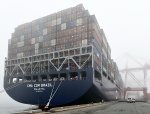You know I've always heard that Conley is just too small and it's not worth the effort to extend the rail line to the property. But I've just read where one of the worlds largest container ships just arrived in Halifax and I was curious about the facilities they have. I was surprised to see that the containerport area on Google maps is about half the size of the newly expanded Conley. It is also rail served.
Also Saint John is in the planning stages of a major expansion but again I found it to be much smaller than Conley and it already has double-stack CP trains going there. Throw Prince Rupert into the comparison mix for size and capability.
So I will say that the old argument that Conley is just too small for a rail connection isn't true. I know there are many other factors to be considered but it seems that Conley could get into the game more if they wanted. These smaller ports are aggressively grabbing as much of this new growing "East Coast" shipping as they can and just maybe are leaving Boston behind.
It's not acreage, it's facilities setup and volume processing. Halifax legit dwarfs the whole of Port of Boston on the volumes they're able to speed-transload.
I don't have a great explainer to give as to the numerous why's because too much of that port freight economics stuff is way above my head to begin with; I'm not well-equipped to layman's-terms arcane stuff where I'm still the layman on the learning curve. But let's just say amongst the industry-folk who know what they're talking about, it's no comparison. Port of Boston is every bit the complicated-case 'tweener conventional wisdom says it is...and the St. Lawrence ports rake intermodal loads at processing rates we can only dream of. The degree-of-difference is totally real-as-advertised, and drayage economics do not display any uncovered flanks where something needs to step up and plug the gap between the St. Lawrence ports and PANYNJ. Niche specialization, i.e. doing only one thing outside of the throughput of the bulk ports but doing it very well to solidify the niche, is the opportunity all the New England ports of any significance--Portland, Portsmouth, Boston (inclusive of Everett/Chelsea/Eastie + Charlestown + Southie + Quincy), New Bedford, Fall River, Providence, Quonset Point, Groton/New London, and New Haven--have for carving out their presence. We aren't competing with Halifax; that's utterly suicidal strategy for its misread of Port Econ 101.
EDIT: Quick Googlage of
illustrative stats for North American ports. The metric-of-record is TEU's, or "Twenty-foot unit equivalents"...the unit-conversion of gross port tonnage (all means & modes) fitted into hypothetical shipping cube counts. Note that TEU counts can be *very* volatile year-to-year given performance of various economic sectors, with many ports also actively in-process of upgrading capacities which can cause big TEU spikes in the year, say, another newly-dredged PANMAX lane comes online. So the rankings are usually based on many-year or decade-level averages to filter out the jumpy statistical noise.
- Los Angeles, CA -- 7.9 million TEU's
- Long Beach, CA -- 6.1 million TEU's
- New York/New Jersey (PANYNJ) -- 5.5 million TEU's
- Savannah, GA (other rankings list all Georgia ports together) -- 2.9 million TEU's
- Vancouver, BC -- 2.5 million TEU's
- Oakland, CA -- 2.3 million TEU's
- Seattle, WA (other rankings list Seattle & Tacoma together) -- 2.0 million TEU's
- Hampton Roads, VA (other rankings list all Virginia ports together) -- 1.9 million TEU's
- Houston, TX -- 1.9 million TEU's
- Manzanillo, MEX -- 1.8 million TEU's
14. Montreal, QUE -- 1.4 million TEU's
25. Halifax, NS -- 411 thousand TEU's
33. Boston -- 193 thousand TEU's
These are somewhat dated 2011 figures. More current rankings show more or less the same Top 25 and same degree-of-difference between the biggest ports, since all have been upgrading at similar rate. 25-50 has seen some big leaps and falls because of who made upgrades sooner. Overall it's illustrative of the pecking order. Note that Montreal at the terminus of the ocean-navigable St. Lawrence Seaway is the straw that stirs the drink north-of-NYC. Halifax is often a port-of-call en route to Montreal because it faces open ocean vs. St. John in the Bay of Fundy which is usually end of a run, so Halifax's importance gets amplified a bit more by what it's chaining with Montreal. St. John was in the low-40's in 2011, but it's been on upward trajectory post-upgrades. Any which way, Boston is 1/3 the size of Halifax and a fly amongst elephants vs. the Top 15.



